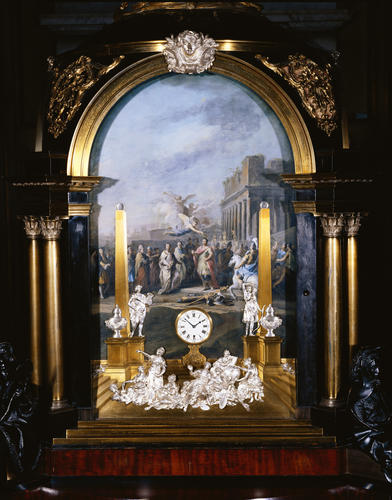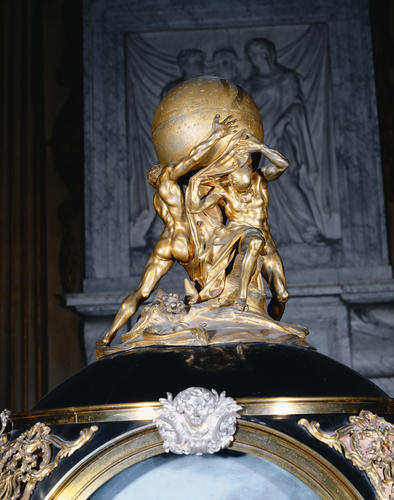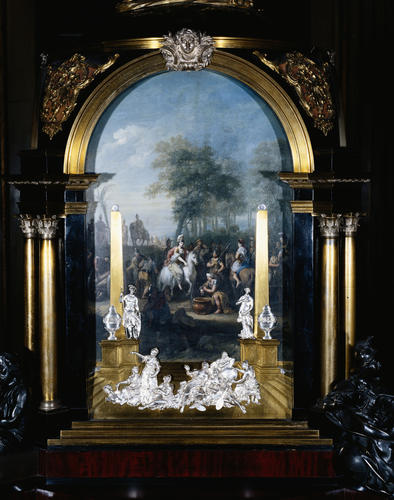Floor standing clock 1730-43
Wood, gilt metal, silver, paint | 85.0 x 81.3 x 81.3 cm (whole object) | RCIN 1418







-
A large square and elaborately decorated musical clock, the four dials painted with allegorical scenes - by Amigoni - and applied silver bas-reliefs - by Rysbrack - and a bronze group with Atlas - by Roubilliac - at the top and corners with applied double columns and four bronze sculptures representing four of the monarchies of the world at the base of the clock. The four faces represent the foundation of the four great empires of antiquity - Assyria, Persia, Greece and Rome.
The creator of the clock, Charles Clay, came from Flockton in the West Riding of Yorkshire. First known when, in 1716, he petitioned the King for a Patent in respect of a repeating device for pocket watches. The application was ultimately unsuccessful following the opposition of the Clockmakers' Company - at a cost to the Company of the not inconsiderable sum of £74 17s. 11d. He arrived in London c. 1720 and set up in premises near St. Mary-le-Strand Church and by 1723 had been appointed Clockmaker to His Majesty's Board of Works in which capacity, in 1731, he made a clock for the gatehouse at St. James's Palace.
The Temple of the Four Great Monarchies of the World was put on display shortly after his death; the clock had been completed by John Pyke, a clock and watch maker of Bedford Row who had been apprenticed in 1710 and admitted to the Freedom of the Clockmakers' Company in 1720.
A newspaper cutting of 31 December 1743 describes the clock 'A DESCRIPTION of a most magnificent and curious MUSICAL MACHINE, CALL'D The temple of the four Grand Monarchies of the World (viz. the Assyrian, the Persian, the Grecian, and the Roman) which were founded by Ninus, Cyrus the Great, Alexander the Great, and Augustus Caesar. Begun by the late ingenious MR CHARLES GRAY, and finish'd y Mr PYKE, Clock and Watchmaker, in Bedford-Row, London. The whole having cost upwards of 45000l. and is to be seen every day at the corner of Brownlow Street facing Bedford-Row, near Gray's inn, London, from ten 0'Clock in the Morning till Seven in the Evening..........
'The Musick consists of an agreeable Variety of Pieces, composed by the three great Masters Geminiani, Handel and Corelli; and properly adapted to the machine by mr Geminiani. It performs not only in Concert, but alternatively on several Instruments, in a most surprising manner, exceeding the Performance of the best Hands.'
The advetisement continues with a description of the four faces:
'This Temple has four front avenues leading into it, through which you may see the Subjects relating to each Monarchy finely represented in Historical Painting. By Signor Amiconi.
'At the entrance of each Avenue is represented in Sculpture the Genii of the Arts and Sciences as Paintings, Sculpture, Geometry, Musick, Architecture, Arithmetick, and Astronomy, all which Sciences have been used in the building and adorning this Fabrick. They are made of Silver in Alto Relievo, by Mr. Rysbrack and are reposing on a Piece of Architecture in Basso Relievo, made of Brass, in true Perspective; by the Obelisks on which stand eight Deities in Silver, in their respective Attitudes, as having some Allusion to the Subjects of each Piece of Painting. These represent some remarkable Passage in the Lives of the before mentioned famous Founders of these memorable Monarchies.
'The first Piece of Painting represents Ninus setting up his Father's image and using it to be worshipped, making it an awful Asylum for all Sort of Malefactors and granting every Petition made to it, which proved the Beginning of Idolotary. The presiding Deities are Cybele and Saturn; Cybele represents the Earth and is call'd the Mother of all Gods; and Saturn, said to be the same with Noah, was the Ancestor of Nimrod, or Belus, who was the Father of Ninus.
'The second Piece represents the Tragic Death of Cyrus, the Founder of the Persian Monarchy, by Thomyris, Queen of the Massigetes, a Nation of the Scythians, who having laid in Ambush for him and slain him, cut off his head and before her Attendance putting it into a Tub of Blood, said, Cyrus, now take thy fill of Blood, which thou has always thirsted afters. The Deities that preside here are Mars and Venus. Mars was particularly ador'd by the Scythians, who build him a Temple of Iron; and Venus was adored by the Persians under the Title of Venus Coelestis.
'The third Piece is the Marriage of Alexander the Great, at Susa, with Statira, the Daughter of Darius. This Hero put an End of the Persian Monarchy, and established the Grecian. The Presiding Gods are Jupiter and Mercury; the former alludes to Alexander's pretending to descend from Jupiter Ammon, the other to the dexterous Genius of the Greeks, who excelled all other Nations at that Time in most kinds of Knowledge and Learning.
''The fourth Piece represents Augustus Ceasar giving Peace to Rome by the Deaths of Brutus and Cassius and the Overthrow of Mark Anthony, after which Augustus was peaceably acknowledge Emperor by the whole Roman People. Here are the images of Apollo and Diana; Apollo's Temple there being one of the riches and beautifullest of all Antiquity.'
The original movement, including a musical mechanism, and stand missing.Provenance
Acquired by Augusta, Princess of Wales, c. 1743 and placed in the Cupola Room at Kensington Palace.
-
Creator(s)
(clockmaker (original movement))(clockmaker (original movement))(nationality)(nationality)Acquirer(s)
-
Medium and techniques
Wood, gilt metal, silver, paint
Measurements
85.0 x 81.3 x 81.3 cm (whole object)
Object type(s)
Alternative title(s)
Temple of the Four Grand Monarchies of the World








